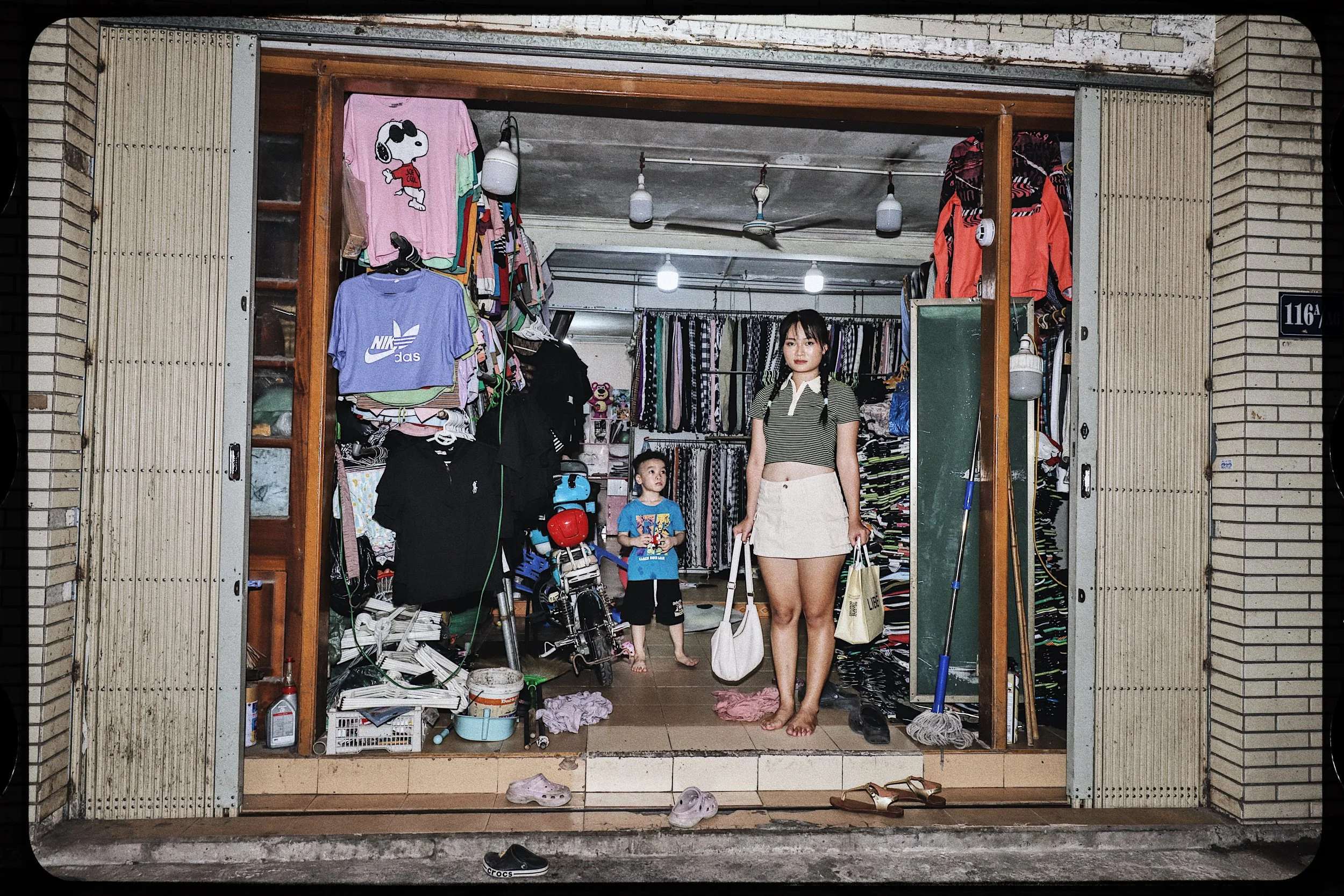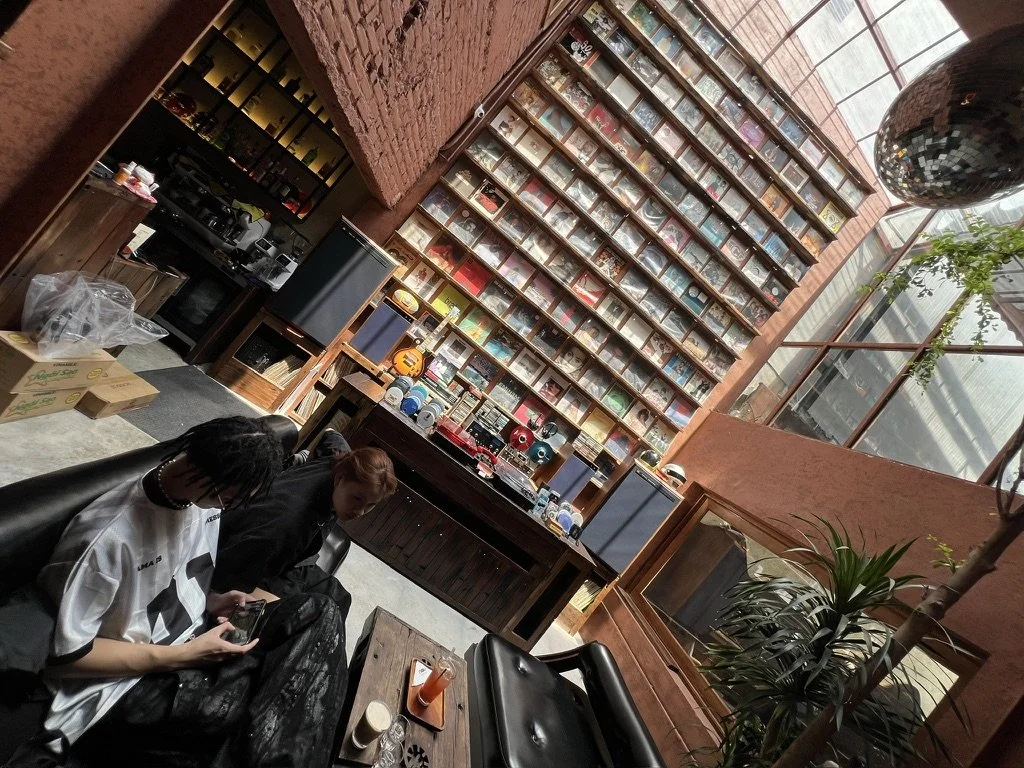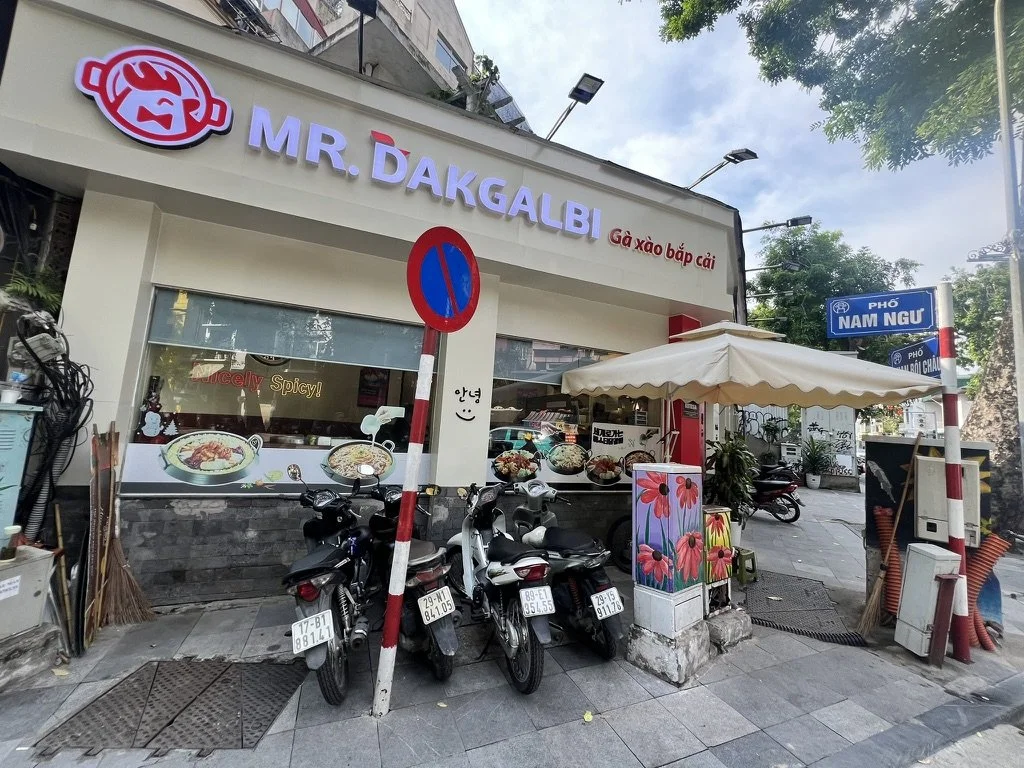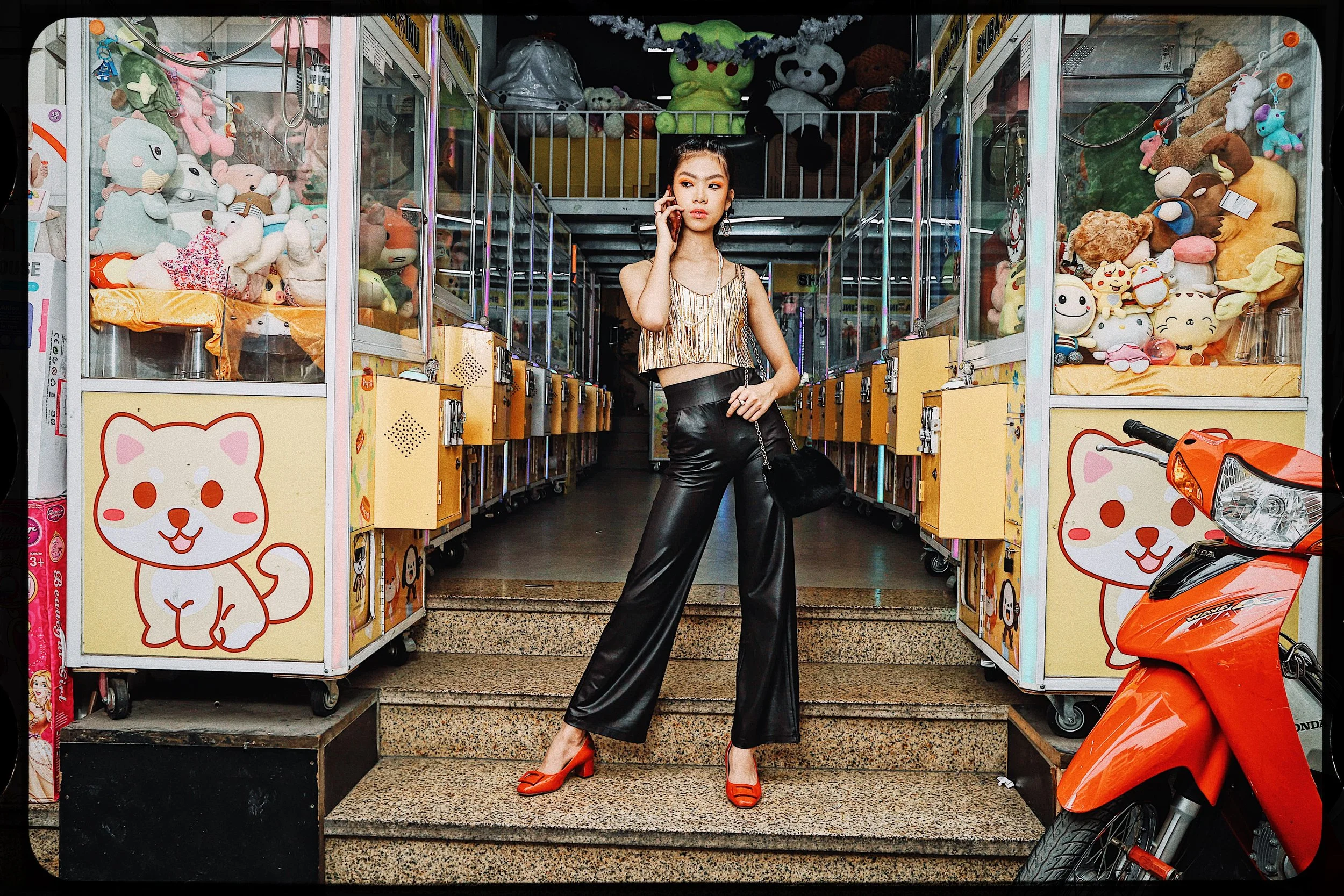Vietnam 4-Day Ethnographic Research Program
Our local Vietnamese model/fixer/translator asked to shoot inside one of the makeshift clothing stores that serve the socialist-era housing complex designed to create community according to socialist principles, but which Hanoians on the ground adapted to the more everyday, market-based realities of selling affordable, fashionable clothes to their neighbors.
"Hallyu in Hanoi" Winter Expedition
Organized by Research Approach
What Makes This Program Unique
This is not a tourism experience or a service trip. This is PhD-level ethnographic research training compressed into an intensive 4-day field expedition. You'll work directly with Dr. Michael Hurt (PhD, UC Berkeley) learning professional research methodologies that most students don't encounter until graduate school.
What You'll Actually Learn:
Most high school programs tell you about research. We teach you how to do research—then let you do it. You'll learn systematic data collection, analytical frameworks, theoretical application, and professional writing. You'll emerge with actual research skills, not just cultural awareness.
Why Ethnography Matters:
Ethnography—the systematic study of people and cultures through direct observation—is the foundation of anthropology, sociology, urban studies, and design thinking. It's how Google understands users, how architects design spaces, how journalists report stories, and how social scientists understand cultural change. These skills transfer to any field requiring deep understanding of how people actually behave versus how they say they behave.
The Confidence Factor:
By the end of this program, you'll have conducted original research, worked with real subjects, navigated a foreign city independently, and produced publication-quality work. You'll have proven to yourself—and can demonstrate to colleges—that you can handle sophisticated intellectual work. This isn't hand-holding; it's intellectual boot camp that shows you're capable of university-level scholarship.
Your PhD-Level Mentor:
Dr. Hurt has spent 20+ years developing these methodologies through fieldwork across Seoul, Hanoi, Saigon, Danang, and Yogyakarta. He publishes in peer-reviewed journals, presents at academic conferences, and trains graduate students. Now he's teaching these same methods to motivated high school students who want to do real research, not simulate it.
Using photo-sartorial elicitation as a point of entry, in which a model asks to pose in a space to gain permission to access it, we were able to interact with the mother/owner of the shop, along with her kids, who were curious about the process. It was the only way we knew how to talk with residents of this KTT complex, where tourists rarely go or even know about.
CATEGORY A: CULTURAL TRANSMISSION & IDENTITY
How Korean culture moves between people and shapes identity
TRACK 1: "Hallyu in Hanoi" - Cultural Influence Interviews
Interview 30+ Vietnamese youth about how K-pop, K-dramas, and Korean culture affect their lives. This track applies cultural transmission theory—the study of how culture spreads between populations through media, contact, and social learning—to understand why Korean cultural elements have become so influential among Vietnamese youth. Visit popular hangout spots, document what's trendy, analyze patterns of adoption. Perfect for students who like talking to people and understanding social trends.
What You'll Do:
Conduct structured interviews with Vietnamese students
Visit cafés, malls, and youth cultural spaces
Document responses and identify patterns
Analyze what makes Korean culture appealing
Apply cultural transmission theory (how culture spreads between populations through media, contact, and social learning)
Skills Developed:
Professional ethnographic interviewing
Pattern recognition in qualitative data
Cross-cultural communication
Research paper writing
Best For Majors: Sociology, Psychology, Cultural Studies, Journalism, International Relations, Asian Studies
College Application Strength: Liberal arts colleges, sociology/anthropology programs, Asian Studies, international relations. Demonstrates research skills and cross-cultural competence.
TRACK 2: Vietnamese Youth Identity & Generational Negotiation
Investigate how Korean culture creates generational differences between Vietnamese parents and kids. This track applies safe space theory—studying how certain locations enable cultural expression that's forbidden elsewhere—to map where Vietnamese youth can and cannot perform Korean aesthetics. Interview students about where they can/can't wear Korean fashion, what parents approve/disapprove, how they negotiate competing cultural pressures and create zones of permitted transgression.
What You'll Do:
Interview youth about family dynamics
Map spatial restrictions on Korean fashion
Document generational conflict and negotiation
Analyze how youth navigate competing cultural pressures
Apply safe space theory (how certain locations enable cultural expression that's forbidden elsewhere)
Skills Developed:
Understanding cultural boundaries
Mapping social permission/prohibition
Family dynamics analysis
Identity formation theory
Best For Majors: Psychology, Sociology, Anthropology, Social Work, Youth Studies, Gender Studies, Asian Studies
College Application Strength: Psychology programs, family/youth studies, cultural anthropology, sociology. Shows ability to navigate complex social dynamics and theoretical analysis.
TRACK 3: K-pop Dance & Embodied Cultural Learning
Observe Vietnamese dance studios teaching K-pop choreography. This track explores kinesthetic empathy—how people absorb cultural knowledge through watching bodies move, not through words or conscious learning. Interview dancers about how they learn moves, what makes dancing "feel Korean," and how they practice. Document the gap between what dancers can perform and what they can articulate verbally, revealing how embodied cultural knowledge operates below consciousness.
What You'll Do:
Observe dance classes and practice sessions
Interview dancers and instructors
Document learning processes
Analyze embodied vs. verbal knowledge transfer
Study kinesthetic empathy (how people absorb cultural knowledge through watching bodies move, not through words or conscious learning)
Skills Developed:
Observational research methods
Understanding embodied learning
Performance analysis
Kinesthetic empathy theory
Best For Majors: Dance, Theater/Performance Studies, Kinesiology, Cognitive Science, Neuroscience, Anthropology, Physical Education
College Application Strength: Performance studies programs, dance/theater, cognitive science, neuroscience, kinesiology. Unique intersection of embodied practice and academic research.
CATEGORY B: SPATIAL ETHNOGRAPHY & URBAN INTERFACES
How spaces shape culture and where different urban systems meet
TRACK 4: "Korean" Café Spaces & Material Culture Mapping
The Nậu Café & Cassette Workshop — which a local coffee shop owner and others told us was the most "Korean café" in Hanoi. This is a pretty common idea in Vietnam — that certain places filled with global (esp. American) style markers are “Korean.”
Photograph and document cafés that Vietnamese consider "Korean-style." This track tests the Standing Wave Model—when Korean and local cultural "waves" meet at the same frequency, they create stable resonance points where certain aesthetic combinations persist. Analyze décor, furniture, music, atmosphere. Interview owners about design choices and customers about why they come. Investigate the puzzle of why spaces labeled "Korean" often contain predominantly American hip-hop aesthetics.
What You'll Do:
Systematic photography of café interiors
Document every material element (furniture, lighting, music)
Interview owners and customers
Analyze cultural labeling processes
Test the Standing Wave Model (when Korean and local cultural "waves" meet, they create stable resonance points where certain aesthetic combinations persist)
Skills Developed:
Visual ethnography techniques
Material culture analysis
Spatial documentation
Cultural translation theory
Best For Majors: Architecture, Interior Design, Art History, Visual Studies, Consumer Psychology, Marketing, Anthropology
College Application Strength: Architecture schools, design programs, visual culture studies, consumer psychology. Creates visual portfolio combined with analytical research.
TRACK 5: Urban Interfaces - Where Korean Culture Lives in Hanoi
Mr. Dakgalbi is one of many specific interfaces through which Vietnamese come into concrete contact with “Korea.”
Map WHERE Korean cultural elements appear across different types of urban spaces using urban interfaces theory—the idea that cultural activity concentrates where different urban systems (commercial, residential, educational, leisure) intersect and overlap. Study these intersections: university districts (student culture + café culture), Old Quarter (tourism + local life + commerce), malls (youth culture + commercial space). Document how Korean influence appears differently depending on which urban systems are intersecting. Analyze why certain interface zones enable Korean expression while others suppress it.
What You'll Do:
Map Korean cultural presence across urban zones
Identify interface points (where different systems meet)
Document how context shapes cultural expression
Analyze spatial permission structures
Apply urban interfaces theory (the idea that cultural activity concentrates where different urban systems—commercial, residential, educational, leisure—intersect and overlap)
Skills Developed:
Urban spatial analysis
Interface theory application
Geographic mapping
Systems thinking
Best For Majors: Urban Planning, Urban Studies, Geography, Architecture, Sociology, Environmental Design, Public Policy
College Application Strength: Urban studies/planning programs, geography, architecture, sociology. Demonstrates systems thinking and sophisticated spatial analysis—particularly strong for competitive programs.
TRACK 6: Shopping & Consumer Space Ethnography
The “Korean” cosmetics brand Mumuso in a Danang shopping mall takes on the advantageous market position of being “Korean” in Vietnam.
Visit shops selling Korean cosmetics and fashion to study cultural translation — how local actors actively modify and adapt foreign cultural elements rather than simply copying them. Interview store owners and Vietnamese customers about what they buy and why. Map commercial districts, analyze product placement, track what gets adopted directly versus what gets adapted. Document how consumer spaces function as active cultural translation sites where Vietnamese consumers curate and legitimize Korean products through local cultural logic.
What You'll Do:
Visit Korean cosmetics and fashion shops
Interview store owners and customers
Track what gets purchased vs. browsed
Map commercial district patterns
Study cultural translation (how local actors actively modify and adapt foreign cultural elements rather than simply copying them)
Skills Developed:
Consumer behavior analysis
Retail ethnography
Market research techniques
Cultural adaptation tracking
Best For Majors: Business Administration, Marketing, Economics, Consumer Psychology, International Business, Retail Management, Entrepreneurship
College Application Strength: Business schools, marketing programs, consumer behavior studies, economics. Shows market research skills and entrepreneurial thinking.
CATEGORY C: VISUAL DOCUMENTATION & PERFORMANCE
Embodied culture captured through photography and observation
TRACK 7: Editorial Fashion Photography - Staged "Korean Style" Sessions
A Vietnamese teen model poses in what she, her mother/stylist, and makeup artist constructed as “Korean style” in the Old Quarter of Hanoi, Vietnam in February 2020.
Recruit Vietnamese models for planned fashion photoshoots using photo-sartorial elicitation methodology to study tacit knowledge — Polanyi's theory that "we know more than we can tell." Give subjects the prompt "Show me Korean style" and let them style themselves. Create professional editorial-style images in chosen locations. This is CONTROLLED, COLLABORATIVE image-making with willing participants who prepare specifically for the shoot. Interview subjects about their styling choices afterward to reveal the gap between what they can perform (embodied knowledge) and what they can articulate verbally (explicit knowledge).
What You'll Do:
Recruit 5-8 Vietnamese models via Instagram
Conduct 2-3 hour photo sessions
Let subjects self-style and choose locations
Post-shoot interviews about choices
Create professional editorial portfolio
Test tacit knowledge theory by documenting the gap between what people can show (styling performance) and what they can explain (verbal articulation of "why")
Skills Developed:
Portrait and fashion photography
Working with models
Photo-sartorial elicitation methodology
Understanding embodied knowledge
Portfolio creation
Best For Majors: Photography, Studio Art, Fashion Design, Visual Anthropology, Art History, Film/Media Studies
College Application Strength: Art schools, photography programs, fashion studies, visual anthropology. Creates professional portfolio piece.
Note: This is PLANNED, STAGED photography with recruited participants who prepare specifically for the shoot—like working on a magazine editorial.
TRACK 8: Street Fashion Documentation - Real People, Real Moments
This clothing store worker at The New Playground complex in Saigon told us she thought it was cool how Korean girls did this style in Korean dramas, so she started doing it as well. It was fascinating how many Korean-styled people we met here, in a Dongdaemun Migliore-style mall complex considered THE cool place to be in Saigon in 2017.
Walk Hanoi streets applying performance theory—Goffman's distinction between "front stage" (how people present themselves when aware of being watched) and "back stage" (everyday unguarded behavior). This DOCUMENTARY photography captures strangers going about their day wearing Korean-influenced fashion—unplanned and natural. Requires quick observation skills, respectful approach techniques, and the ability to spot Korean aesthetic elements "in the wild." Approach subjects afterward for brief interviews. Documents the difference between performed identity (Track 7's staged sessions) and spontaneous everyday cultural expression.
What You'll Do:
Walk busy Hanoi districts spotting fashion
Photograph strangers (with permission) in real time
Conduct quick interviews on the spot
Document spontaneous style choices
Analyze patterns across contexts
Test performance theory by comparing "front stage" staged behavior (Track 7) with "back stage" everyday fashion choices
Skills Developed:
Street photography techniques
Quick observational skills
Respectful approach strategies
Spotting cultural patterns "in the wild"
Documentary ethics
Best For Majors: Photojournalism, Documentary Studies, Anthropology, Sociology, Media Studies, Asian Studies, Cultural Studies
College Application Strength: Journalism programs, documentary studies, cultural anthropology, sociology. Shows initiative and real-world research skills.
Note: This is UNPLANNED, DOCUMENTARY photography of real people in their normal daily lives—like photojournalism, not fashion editorials.
How to Choose by Major
Applying as Social Sciences major?
→ Category A (Cultural Transmission & Identity)
Sociology/Anthropology → Track 1
Psychology/Social Work → Track 2
Performance Studies/Kinesiology → Track 3
Applying as Design/Architecture/Urban Studies major?
→ Category B (Spatial Ethnography & Urban Interfaces)
Architecture/Interior Design → Track 4
Urban Planning/Geography → Track 5
Business/Marketing → Track 6
Applying as Arts/Media major?
→ Category C (Visual Documentation & Performance)
Photography/Studio Art → Track 7
Photojournalism/Documentary → Track 8
Category Combinations:
Students can also combine approaches across categories for richer research:
Suggested Pairings:
"Spaces + People"
Track 4 or 5 + Track 1
Document cafés AND interview the people in them
Understand both environment and experience
"Bodies + Spaces"
Track 3 or 7 + Track 5
Study dance/fashion performance in specific urban interfaces
See how space shapes embodied expression
"Shopping + Identity"
Track 6 + Track 2
Consumer behavior shaped by family/generational dynamics
Link purchasing decisions to identity negotiation
"Editorial + Street"
Track 7 + Track 8
Both staged and documentary photography
Complete picture of performed vs. natural style
"Interviews + Photography"
Track 1 + Track 7 or 8
Combine verbal responses with visual documentation
Triangulate what people say vs. what they show
Program Structure: All Tracks Include
Pre-Departure (Seoul)
Theoretical framework workshops
Methodology training sessions
Photography skills development (for visual tracks)
Reading assignments and discussion
Interview protocol practice
Equipment preparation
4-Day Hanoi Field Research
Day 1: Reconnaissance and site mapping
Days 2-3: Intensive data collection
Day 4: Synthesis and preliminary analysis
Daily debriefs with research team
Ongoing documentation and field notes
Post-Return (Seoul)
Data organization and coding
Pattern recognition analysis
Comparative framework development
Research paper or portfolio creation
Presentation preparation
Publication-quality deliverable
Research Deliverables by Track
Tracks 1-3 (Cultural Transmission): 15-20 page research paper, interview transcripts and analysis, pattern identification report
Tracks 4-6 (Spatial Ethnography): Visual documentation portfolio, spatial analysis maps, research paper with photos, material culture inventory
Tracks 7-8 (Visual Documentation): Professional photo portfolio (20-30 images), artist statement, interview transcripts, visual ethnography analysis
College Application Value
All tracks provide unique international research experience with professional methodology training, publication-quality deliverables, demonstrated initiative and independence, and cross-cultural competency.
Each track description above includes specific college program strengths.
Participant Requirements
All Tracks: Strong English communication, intellectual curiosity, independence, cross-cultural respect, initiative
Photography Tracks (7-8): Basic photography skills or willingness to learn, own camera, eye for composition, comfort approaching strangers (Track 8)
Interview Tracks (1-3, 6): Conversational skills, active listening, patience, note-taking discipline
Spatial Tracks (4-5): Visual observation, systematic documentation, spatial thinking, pattern recognition
Choosing Your Track: Quick Guide by Major
Social Sciences (Sociology, Psychology, Anthropology):
Broad cultural trends → Track 1
Family/generational dynamics → Track 2
Embodied cultural learning → Track 3
Design & Built Environment (Architecture, Interior Design, Urban Planning):
Interior spaces & material culture → Track 4
Urban systems & spatial analysis → Track 5
Business & Economics:
Consumer behavior & markets → Track 6
Arts & Media (Photography, Art, Journalism):
Editorial/fashion photography → Track 7
Documentary/photojournalism → Track 8
For Parents: Program Value
Academic Rigor: University-level research methodology, professional academic output, PhD researcher mentorship, real scholarly contribution
Skill Development: Research design and execution, data collection and analysis, professional writing or photography, cross-cultural communication
College Applications: Unique experience demonstrating intellectual passion, initiative, and independence. Creates compelling essay material and provides specific, verifiable accomplishments.
Strong fit for: Liberal arts colleges, research universities, programs in anthropology, sociology, Asian studies, urban studies, photography, cultural studies, international relations
in a nutshell
All tracks accommodate 8-10 students maximum
Pre-departure prep begins 4 weeks before travel
Total program: 2 weeks (1 week Seoul prep + 4 days Hanoi + analysis)
Program operated by KARSI (Korean Advanced Research & Studies Institute) Research led by Dr. Michael Hurt, PhD (UC Berkeley Comparative Ethnic Studies)






